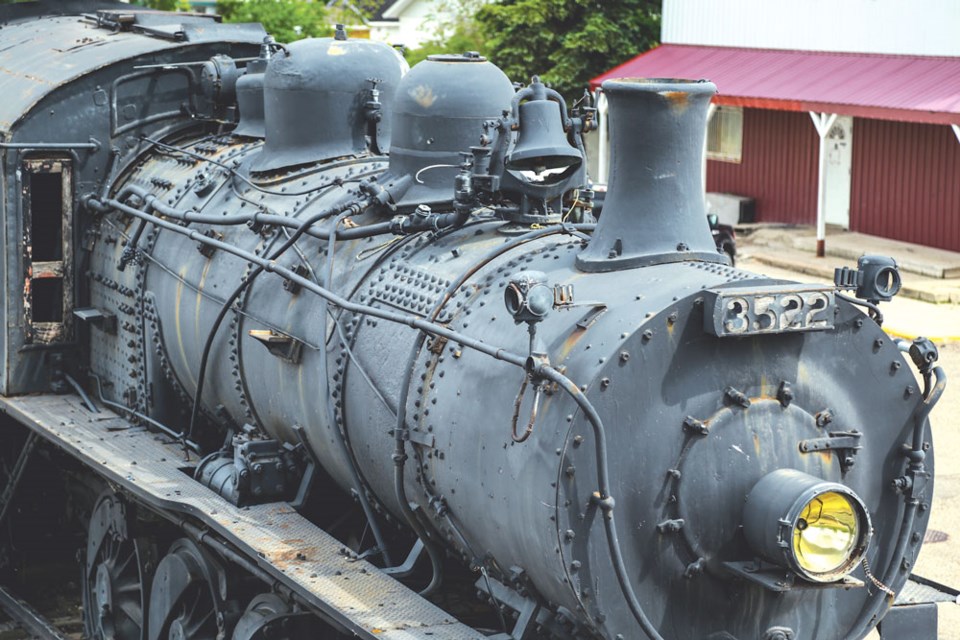Those who are intrigued by the history of steam engines will enjoy The Locomotives of Bienfait, according to William Fraser, the researcher and director for the one-hour documentary.
But he believes it will also be a fascinating film for anyone interested in the history of the Estevan and Bienfait areas.
The Locomotives of Bienfait will premiere at the Orpheum Theatre in Estevan on Nov. 19 and 20. Show time is at 1:30 p.m. each day, and there isn’t a charge to attend.
It’s the first documentary Fraser has directed, and it is being released through his Navion film company.
“In the south Saskatchewan coal mining town of Bienfait, steam locomotives toiled well past the end of mainline steam power in North America,” states the website for the movie. “Miraculously, three of these locomotives survive. The Locomotives of Bienfait brings these iconic machines and the history around them to life.”
The three locomotives are No. 3522, which still sites on display at the end of Main Street in Bienfait, No. 2166, which is now located at the Western Development Museum in Saskatoon, and No. 6947, which is now in Sandon, B.C.
No. 3522 hauled coal for the Manitoba and Saskatchewan Coal Company from 1956 to 1968, when it was retired. It was built in 1907, and was in service for 61 years.
No. 2166 has been restored to its original CP Rail configuration. It was built in 1905, and sold to the Manitoba and Saskatchewan Coal Company in 1949, and remained in operation until it retired.
Finally, No. 6947 was built in 1908, served with the CP Rail, and was sold to the Manitoba and Saskatchewan Coal Company in 1959. It was retired in 1970 and donated to the Alberta Pioneer Railway Association.
According to the website for The Locomotives of Bienfait, in 1998, No. 6947 was sold to its current owner, Hal Wright, who disassembled it and trucked it to his hometown of Sandon, where he reassembled it and put it on display.
Fraser, who now resides in Winnipeg, started to think about the project about two years ago. Then he started contacting people, and looking for resources to make the picture.
“We started filming in June of last year, and finished shooting later in the summer,” he said in an interview with Lifestyles. “And then we’ve been working on editing it ever since, with a few breaks.”
His parents, Hugh and Anne, are from Bienfait originally. Anne, 89, is still alive, and living in Winnipeg.
And his grandfather was a miner who worked for the Western Dominion Colleries mining company.
“Growing up, I used to come to Bienfait with my parents … and there was still a couple of the locomotives operating,” said Fraser. “Later on, I started researching online, and found out that three of them had survived, which was pretty rare, because most steam engines were scrapped in the 1940s, 1950s and 1960s.”
When those engines were turned to scrap metal, people didn’t realize the historical loss, he said.
At one time, the engines were so common that Locomotive 3522 was one of 2,655 built by Baldwin Locomotive Works in Philadelphia in 1907.
Fraser noted he was lucky to find a gentleman whose father had filmed Locomotives 6947 and 3522, and allowed Fraser to use the 16-millimetre film.
“We had the film digitized, so that plays a major role in our documentary, those film clips of the locomotives operating, because it’s great to see them in use,” said Fraser.
There are still a few steam engines that are operational, he said, and others are still on display.
Locomotives of Bienfait also offers a look back at the history of this region. It chronicles coal mining in the Estevan and Bienfait areas, from the turn of the 20th century to the late 1960s, which was the end of the steam engine era in Bienfait. And it provides a look into the mining camps that surrounded the Estevan area, and the Estevan riot of 1931.
“I’m really hoping that most of the details and the historical part of it are correct,” said Fraser. “That’s probably the thing I worry about more than anything, because people who are close to that history will have a much better understanding of it than I do.”
He wanted to create the documentary now while people who witnessed the history are still alive.
A three-minute trailer has been posted on YouTube and the Locomotives of Bienfait website, giving people a glimpse into the film’s content and some of its unique footage.
Fraser looks forward to seeing the finished product on the big screen when it debuts at the Orpheum.
“I’ve been staring at the computer monitor for a year,” said Fraser. “The people at the Orpheum have seen (some of it), I sent them part of it for a test.”
He noted that Alan and Jocelyn Dougherty from the Orpheum offered to run the film, and they have been great to work with.
People he interviewed for the documentary are also expected to attend the premiere. Not only did he speak to three people from Bienfait, as well as those from Saskatoon and Sandon, he interviewed individuals in Summerland, B.C., where a locomotive similar to 3522 is still operating.
Once the documentary finishes its two-day run at the Orpheum, Fraser expects to post it online, so that people who can’t attend are able to see it.
There are still a few little touch-ups remaining on the documentary, but Fraser is thrilled to have the project nearly finished, and he said it will be ready for the premiere in Estevan.



